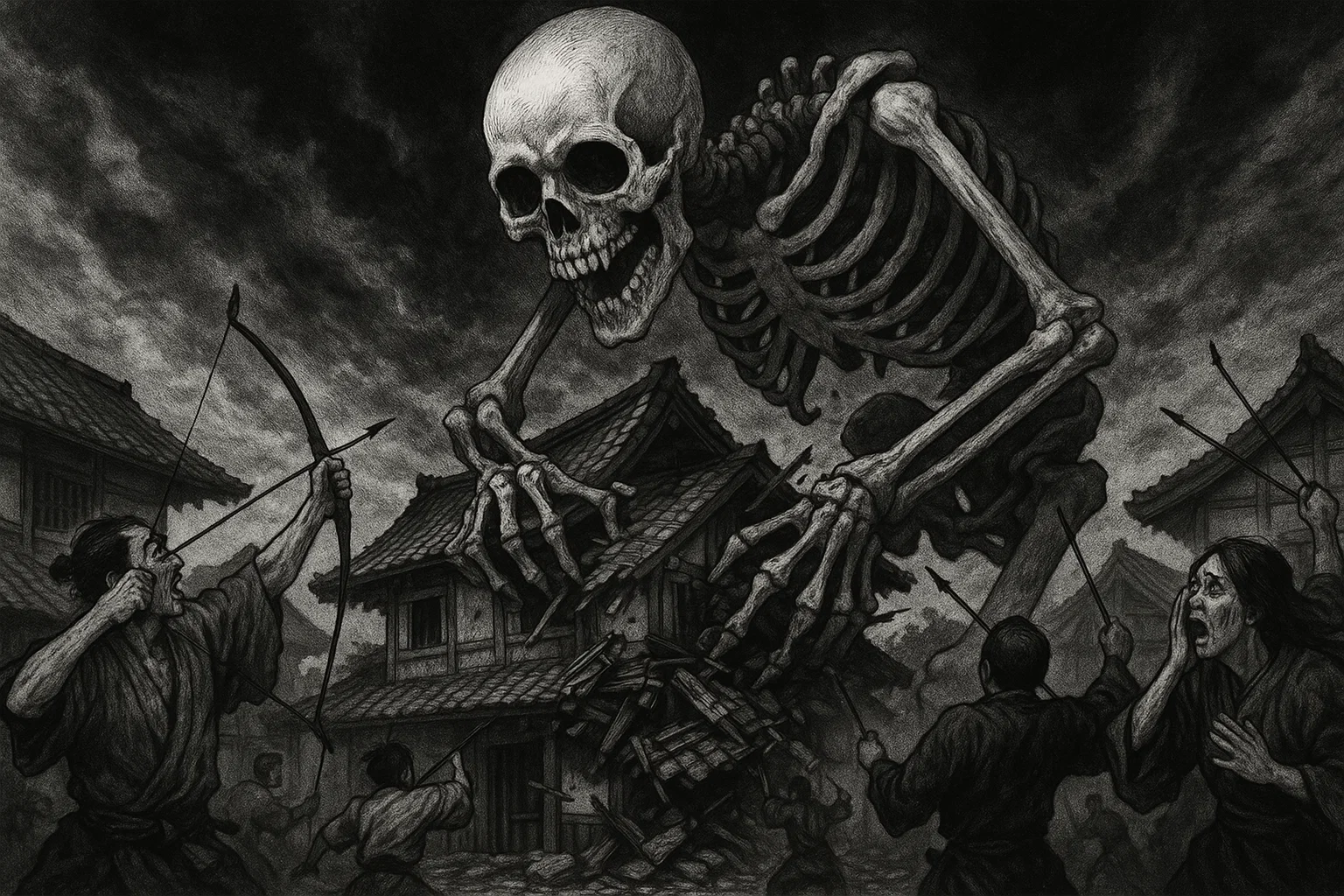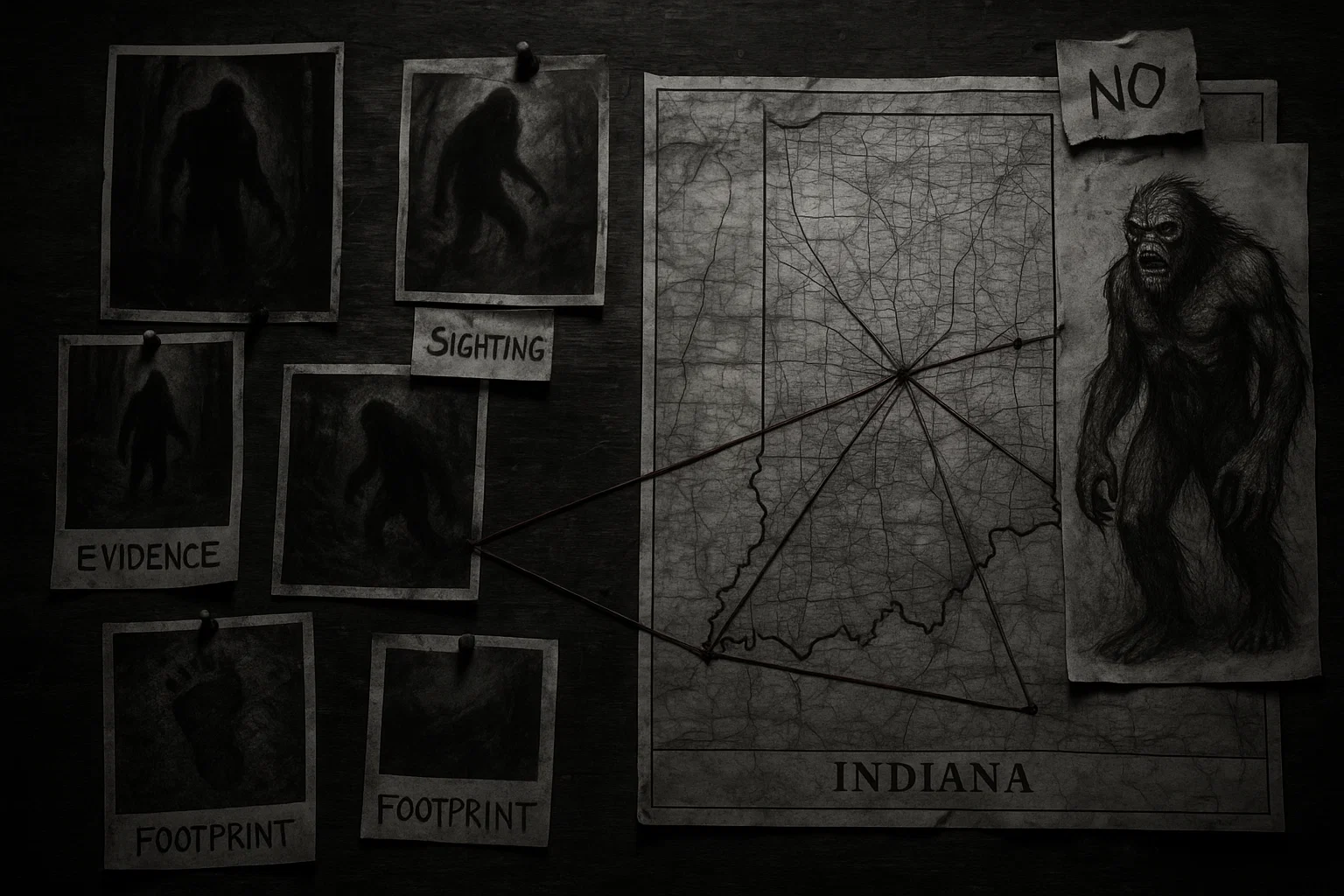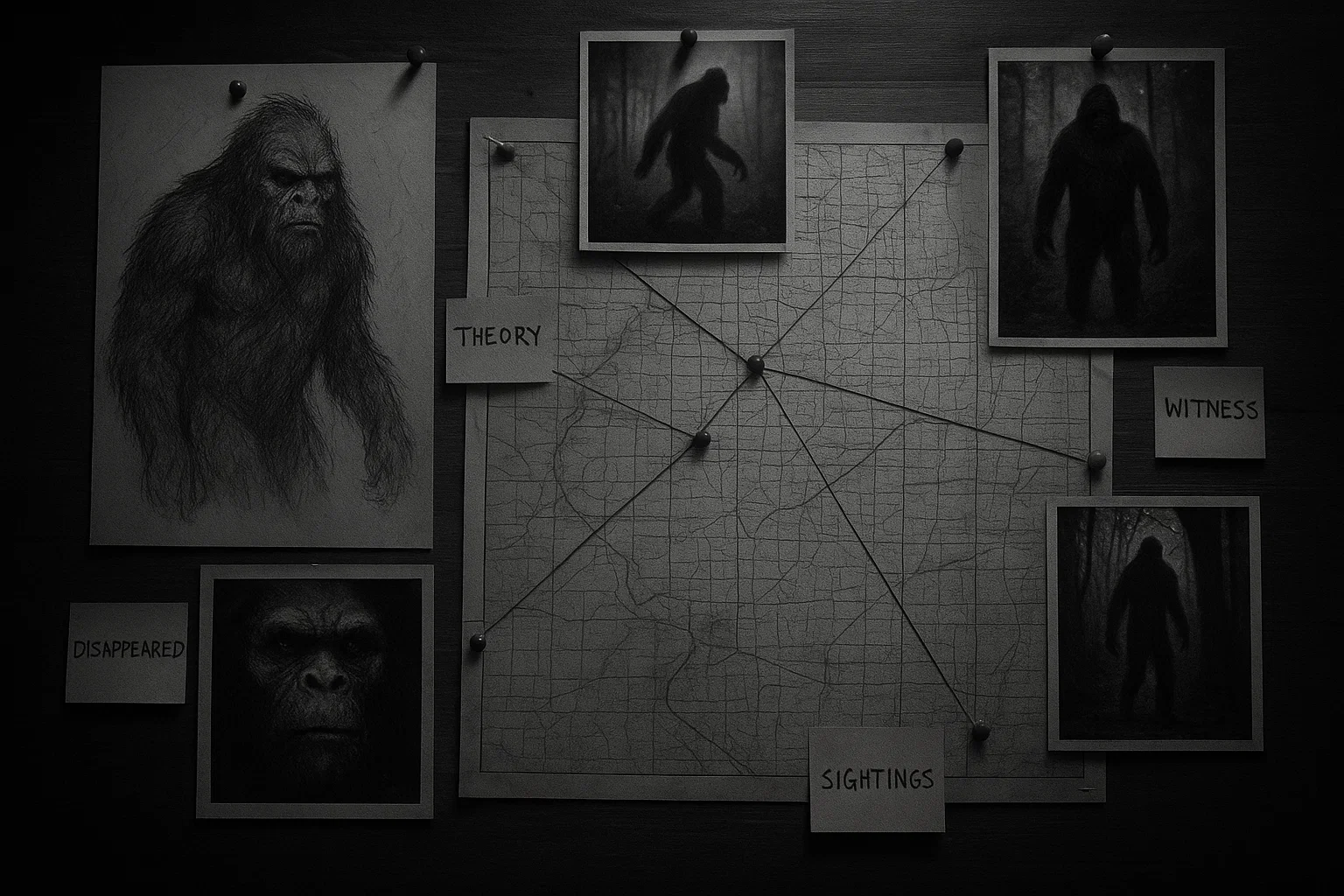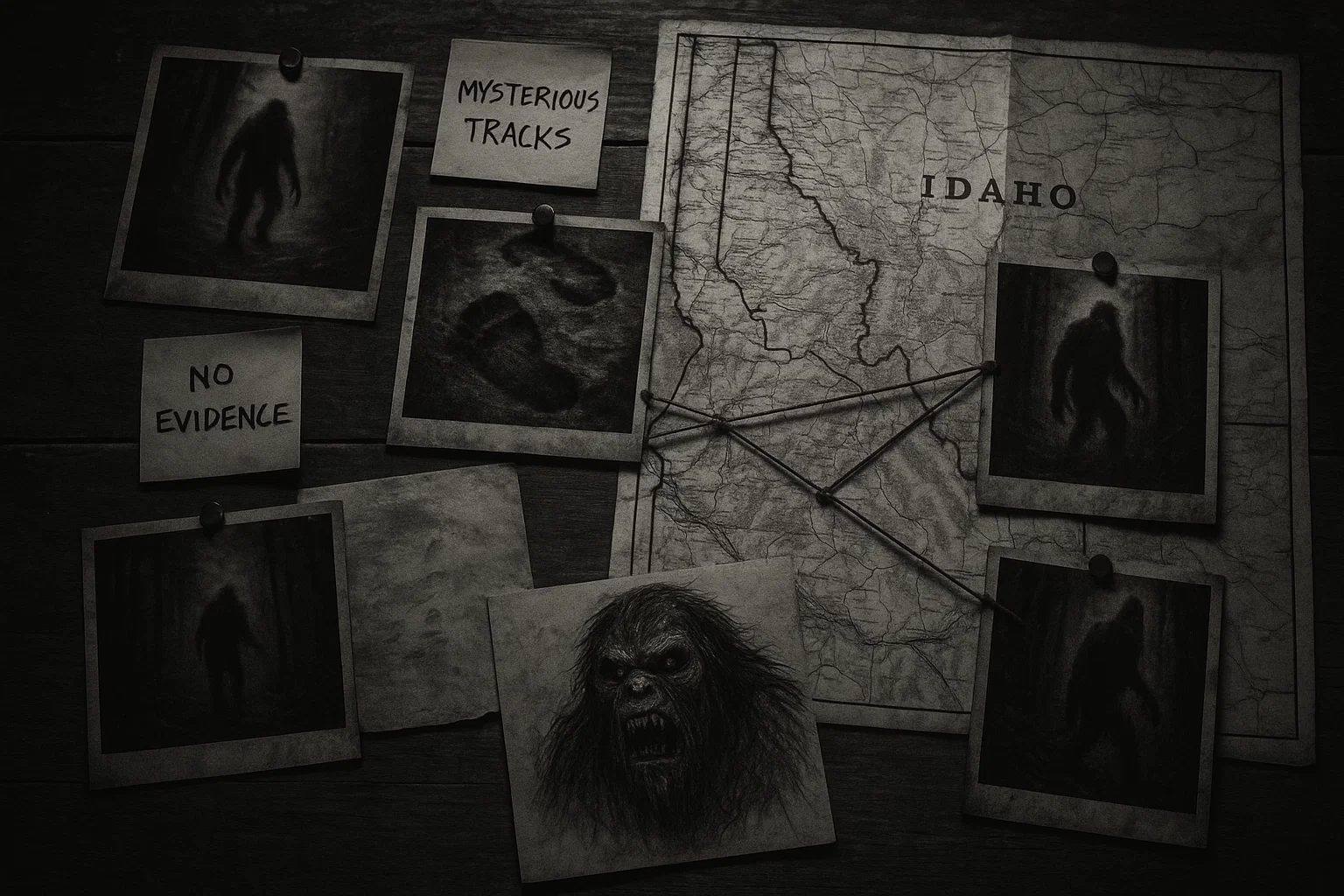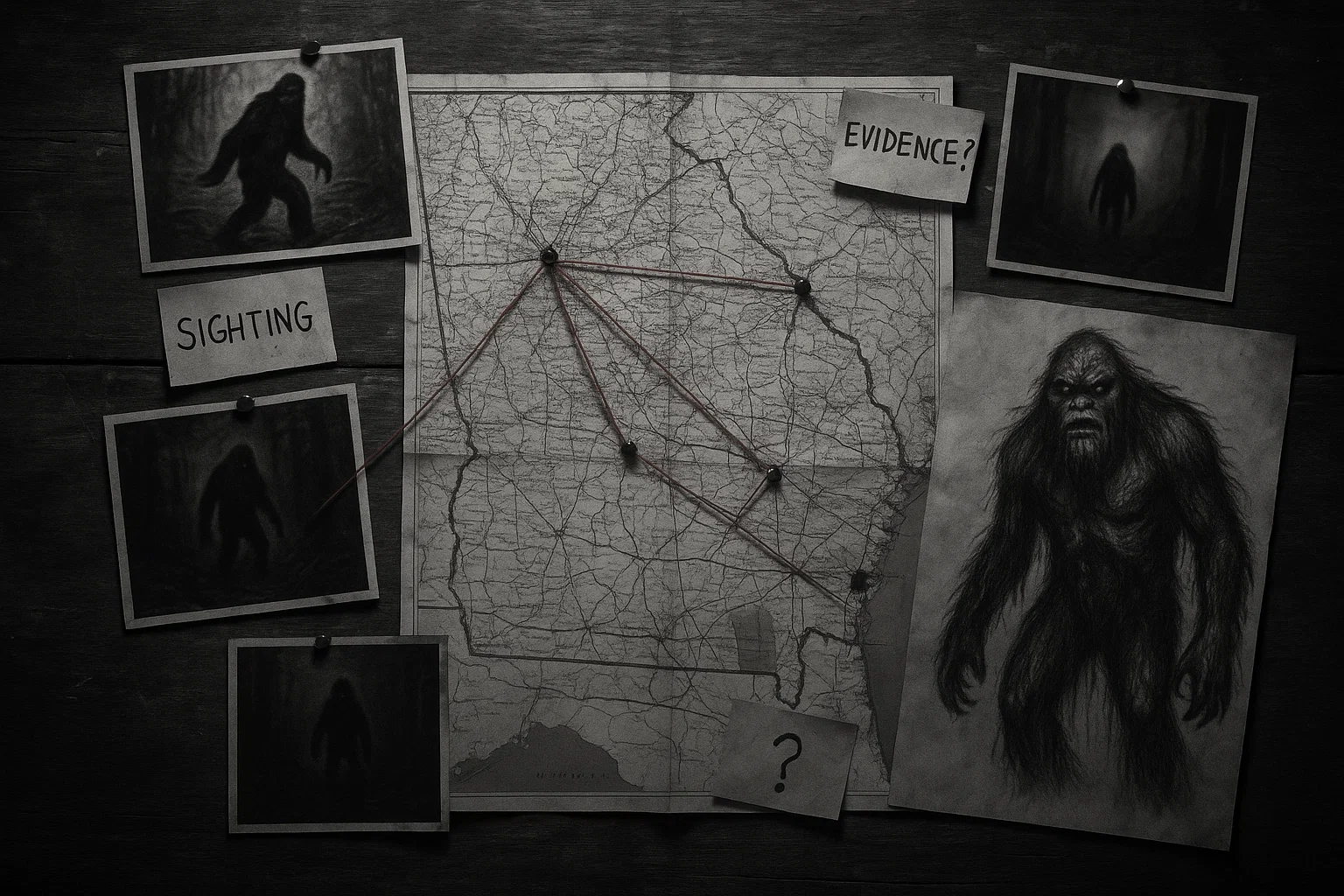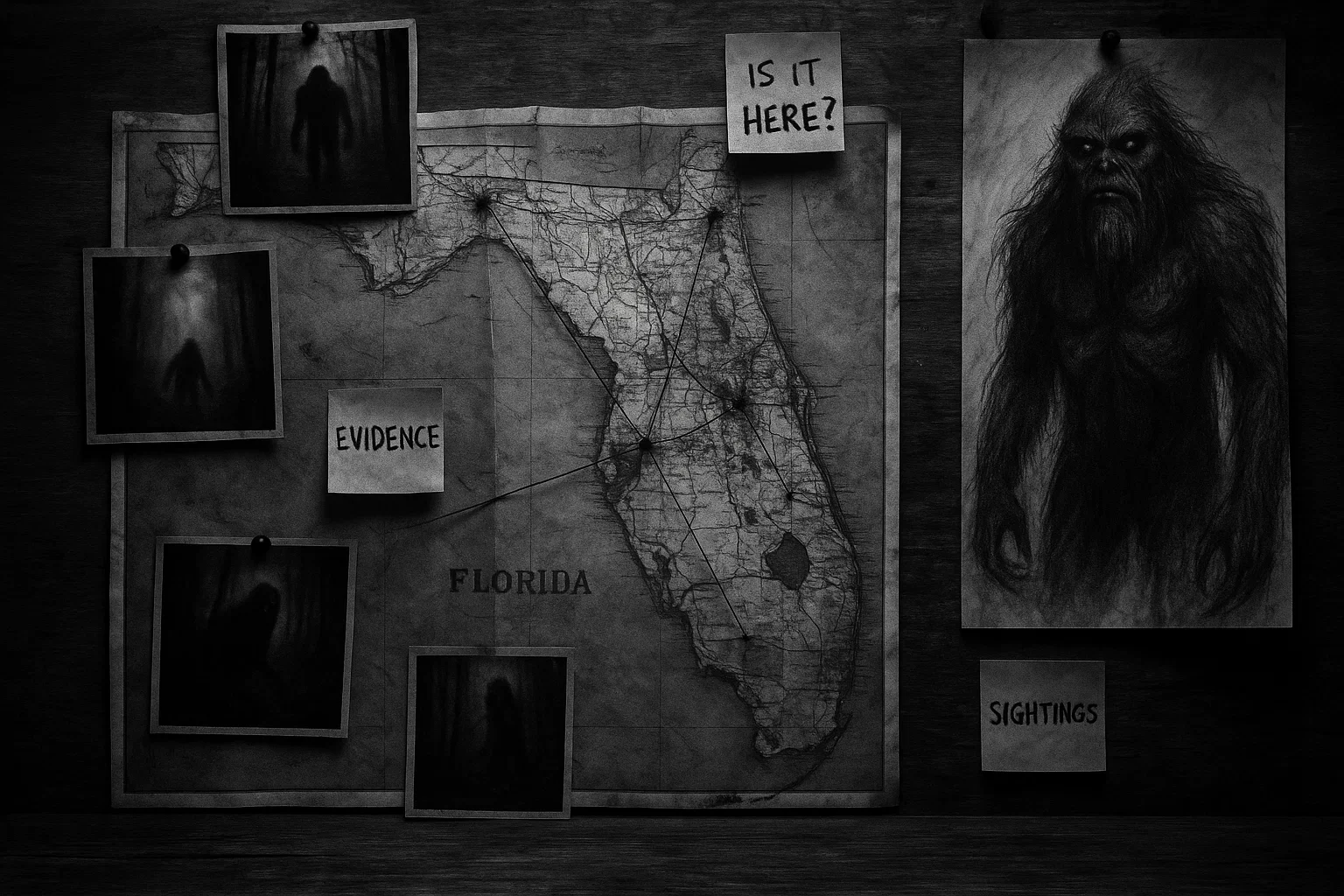Japan’s folklore is a haunting blend of history, spirituality, and the supernatural, where yokai—spirits and monsters—embody cultural fears and moral lessons.
Among these, the Gashadokuro, or “rattling skeleton,” stands as one of the most terrifying. A colossal skeleton formed from the bones of those who died in tragedy, it roams the night seeking vengeance.
Table of Contents
What Does the Gashadokuro Look Like?
The Gashadokuro is a massive skeletal yokai, standing 10 to 90 feet tall—up to fifteen times the height of a human. It is formed from the bones of those who died in battle, famine, or other tragedies, particularly when their bodies were left unburied, fueling a collective grudge.
This resentment binds the bones into a single, vengeful entity that stalks the countryside after midnight, often around 2:00 a.m., when the veil between the living and the dead is thinnest.
Physically, the Gashadokuro is a skeletal giant with hollow sockets that sometimes glow yellow or green, adding to its eerie menace. Its bones clatter with each step, producing a distinctive “gachi gachi” sound, and victims often hear a loud ringing in their ears before it strikes.
Some legends suggest it can become invisible, making it an unpredictable predator. Its size and supernatural nature render it nearly indestructible, a physical manifestation of unresolved sorrow and rage.
What Does a Gashadokuro Do?
The Gashadokuro’s primary activity is hunting lone travelers under the cover of night. It is driven by an insatiable need for vengeance, targeting those unfortunate enough to cross its path.
The creature’s attack is brutal and swift: it grabs its victim, bites off their head with its massive jaws, and drinks their blood, leaving behind a lifeless body. This gruesome act is not merely for sustenance but a manifestation of the grudge held by the spirits whose bones form the creature.
The Gashadokuro does not discriminate in its choice of victims, attacking anyone who wanders alone in its territory. Its presence is often preceded by sensory warnings: a high-pitched ringing in the ears and the unmistakable sound of its bones rattling.
These signs give victims a fleeting chance to flee, though escape is rare due to the creature’s size and speed. In some stories, the Gashadokuro is said to pursue its prey relentlessly, driven by the collective anger of the dead.
You May Also Like: Crowing Crested Cobra: A Real-Life Basilisk or Folklore Beast?
Can a Gashadokuro Be Killed?
The Gashadokuro’s indestructibility is one of its most terrifying traits. As a creature composed of already-deceased bones, it is not alive in the conventional sense, making traditional weapons ineffective.
Physical attacks, such as swords or arrows, pass through its skeletal form or cause minimal damage, as the bones are held together by supernatural forces.
Some legends suggest that the Gashadokuro will persist until its grudge is resolved, which requires appeasing the spirits through proper burial rites or spiritual cleansing.
One modern interpretation, not rooted in traditional folklore, proposes that conducting a mass funeral for the bones could return the Gashadokuro to inert remains.
However, this is impractical, as locating and identifying the specific bones is nearly impossible. In essence, the Gashadokuro cannot be killed through conventional means, making prevention and avoidance the only viable strategies.
How to Survive a Gashadokuro?
Surviving an encounter with a Gashadokuro is a daunting challenge, but folklore offers a few strategies.
The most effective defense is carrying Shinto charms or amulets, which are believed to repel yokai by invoking spiritual protection. These charms, often inscribed with sacred symbols or prayers, create a barrier that the Gashadokuro cannot cross.
Travelers are advised to carry such talismans when journeying through remote areas at night, especially in regions with a history of battles or mass graves.
Another survival tactic is to heed the warning signs: the ringing in the ears and the “gachi gachi” sound. Upon noticing these, one should immediately seek shelter, preferably in a populated area, as the Gashadokuro avoids crowded places.
Hiding in a temple or shrine, sacred spaces protected by Shinto or Buddhist deities, may also deter the creature. Finally, preventing the Gashadokuro’s formation is key—proper burial rites for the dead can ensure their spirits rest peacefully, reducing the likelihood of a Gashadokuro arising.
Are Gashadokuro Evil?
The question of whether the Gashadokuro is evil is complex and rooted in the nature of yokai. The Gashadokuro is not inherently evil in the sense of malevolent intent; rather, it is a manifestation of unresolved grief and anger from the spirits of the unburied dead.
Its actions—killing and consuming victims—are driven by a collective grudge, not a conscious desire to harm. In Japanese folklore, yokai like the Gashadokuro often serve as warnings, embodying the consequences of societal or individual failures, such as neglecting the dead.
Some interpretations view the Gashadokuro as a tragic figure, a product of human neglect rather than an entity with free will. Its existence underscores the importance of honoring the deceased through proper rituals, a core tenet of Japanese culture.
Thus, while its actions are horrific, the Gashadokuro is less an evil being and more a force of retribution, reflecting the pain of those whose deaths were ignored.
You May Also Like: The Conjured Chest: 17 Victims, One Sinister Curse
Historical and Cultural Origins
The Gashadokuro’s legend likely emerged from Japan’s tumultuous history of war and famine, where mass deaths left countless bodies unburied. One of the earliest stories ties the creature to the 10th-century rebellion of Taira no Masakado, a samurai who defied the central government.
After his execution in 940 CE, his daughter Takiyasha Hime, a sorceress, is said to have summoned a giant skeleton to attack Kyoto, seeking vengeance. This tale, depicted in Utagawa Kuniyoshi’s iconic ukiyo-e print Takiyasha the Witch and the Skeleton Spectre, is a cornerstone of the Gashadokuro’s mythology.
Famine also contributed to the legend. During periods like the Great Tenmei Famine (1782–1788), thousands died of starvation, and their unburied remains fueled tales of restless spirits.
The Gashadokuro is closely related to the concept of hidarugami, spirits of starvation victims, but its physical form as a giant skeleton sets it apart. The decline in mass graves in modern times has made Gashadokuro sightings rare, but its stories persist as a reminder of historical suffering.
Specific Horror Stories and Urban Legends
The Gashadokuro features in several chilling tales, each highlighting its terror:
The Samurai’s Curse
In the Heian period, a lone samurai named Hiroshi wandered through the war-torn fields of Oshu, returning from a battle where his clan was decimated.
As midnight passed, he heard a faint ringing in his ears, followed by a rhythmic “gachi gachi” sound. Dismissing it as exhaustion, he continued along a moonlit path.
Suddenly, the ground trembled, and a towering skeleton emerged from the darkness, its eyes glowing green. Hiroshi drew his katana, but his strikes passed harmlessly through the bones.
The Gashadokuro seized him, its jaws snapping shut, and his screams echoed briefly before silence fell. Locals later claimed the creature was formed from the unburied soldiers of Hiroshi’s clan, seeking vengeance for their forgotten deaths.
This story, rooted in the Taira no Masakado rebellion, warns of the consequences of neglecting fallen warriors.
The Village of Starving Souls
During the Great Tenmei Famine, a remote village in northern Japan suffered immense loss.
With no resources for proper burials, the dead were left in a nearby ravine. Years later, travelers began disappearing on the road passing the village.
One night, a merchant named Taro, traveling to sell rice, heard a deafening ring in his ears. As he looked up, a colossal skeleton loomed over the trees, its bones rattling like a storm. Taro, a devout man, clutched a Shinto charm given by a priest and prayed fervently.
The Gashadokuro paused, its glowing eyes fixed on him, then vanished into the night. Taro’s survival spread the tale, and the village conducted a mass burial to appease the spirits, after which the Gashadokuro was never seen again.
The Midnight Traveler
In a modern urban legend from the 1960s, a young man named Kenji, traveling by motorcycle through rural Fukushima, stopped at a deserted crossroads around 2:00 a.m.
A ringing filled his ears, and the air grew heavy with the sound of clattering bones. Turning, he saw a skeletal giant striding toward him, its eyes glowing yellow.
Kenji, recalling his grandmother’s tales, sped toward a nearby shrine, where he hid behind a torii gate. The Gashadokuro circled the shrine but could not enter, eventually fading as dawn broke.
Kenji later learned the area was a former battlefield, its dead left unburied after a skirmish.
You May Also Like: Photographs from Another World | Horror Story
Modern Representations
The Gashadokuro’s cultural significance lies in its role as a cautionary tale. It underscores the importance of honoring the dead through proper burial rites, a key aspect of Shinto and Buddhist practices.
In Japanese culture, neglecting the deceased can lead to restless spirits, and the Gashadokuro embodies this fear on a grand scale. Its story is used in some schools to teach empathy, drawing parallels between the creature’s grudge and the pain of those mistreated or ignored.
In modern media, the Gashadokuro has a strong presence. It first gained widespread attention in the mid-20th century through works like Morihiro Saito’s story in Bessatsu Shoujyo Friend (1966) and Shigeru Mizuki’s Nakayoshi (1967).
Its iconic depiction in Utagawa Kuniyoshi’s 19th-century print continues to inspire artists. The creature appears in video games like Okami and The Legend of Zelda, where its towering form creates a sense of awe and terror.
In anime and manga, such as Hell Teacher Nube, it serves as a formidable antagonist, while horror films use its imagery to evoke primal fears.
Similar Creatures in Other Cultures
While unique to Japan, the Gashadokuro shares thematic similarities with creatures from other cultures, reflecting universal fears of death, neglect, and supernatural retribution:
| Creature | Description | Origin | Behavior |
|---|---|---|---|
| Jiangshi | Reanimated corpse, often stiff and hopping, with pale skin and outstretched arms. | Corpses that fail to rest due to improper burial or unrested spirits; rooted in Qing dynasty folklore. | Attacks at night, drains life force (qi) or blood; repelled by talismans, mirrors, or sunlight. |
| Zombie | Reanimated corpse, often decaying, driven by hunger or external control (e.g., voodoo or necromancy). | Medieval European tales of undead; modernized in Caribbean voodoo and pop culture (e.g., Night of the Living Dead). | Shuffles, eats flesh or brains; relentless pursuit of the living; can be killed by head trauma. |
| Draugr | Animated corpse, often blue-skinned, guarding burial mounds or treasures. | Viking-era Scandinavia; warriors or greedy individuals denied rest due to improper burial or curses. | Attacks intruders, wields supernatural strength; can curse or shapeshift; repelled by iron or fire. |
| Vetala | Spirit possessing a corpse, often hanging upside-down in cremation grounds. | Ancient Hindu texts (e.g., Baital Pachisi); spirits of the improperly buried or restless dead. | Possesses bodies, manipulates minds, causes madness; repelled by mantras or rituals. |
| Rusalka | Water spirit of a drowned woman, often vengeful, luring men to their deaths. | Slavic folklore; young women who died violently or by suicide, often unburied. | Lures men to drown in rivers or lakes; sings haunting songs; repelled by protective charms. |
| La Calavera | Animated skeleton, often depicted in Day of the Dead imagery, sometimes malevolent in folklore. | Pre-Columbian Mesoamerican beliefs; merged with Spanish Catholic traditions. | In folklore, may haunt or curse the living if not honored; in modern culture, a celebratory symbol. |
| Egungun | Ancestral spirit, sometimes manifesting as a masked figure or animated remains. | Yoruba tradition; spirits of ancestors not properly honored through rituals. | Can bless or curse the living; appears during festivals or to punish disrespect. |
| Keres | Death spirits, often winged, associated with violent deaths on battlefields. | Ancient Greek mythology; daughters of Nyx, linked to unburied soldiers. | Haunt battlefields, feast on blood of the fallen; bring disease or doom. |
| Gwishin | Ghost of a person who died tragically, often with unfinished business. | Korean shamanism; spirits of those who died violently or without proper rites. | Haunts specific places, seeks resolution or revenge; repelled by shamanic rituals. |
| Dullahan | Headless horseman carrying its head, a harbinger of death. | Irish folklore; possibly a warrior denied proper burial or cursed by fairies. | Rides at night, calls names of those doomed to die; repelled by gold objects. |
| Zombi | Reanimated corpse controlled by a bokor (sorcerer); lacks free will. | Haitian Vodou; bodies raised through necromancy, often due to improper burial. | Obeys bokor |
The Gashadokuro is uniquely Japanese, but similar entities exist globally, reflecting universal fears of the unrested dead.
In Chinese folklore, the jiangshi, a hopping corpse, shares the Gashadokuro’s connection to improper burial but lacks its skeletal form.
Western traditions feature zombies and ghosts, which arise from unfinished business or neglected rites, though they are less physically imposing.
In Norse mythology, draugr—animated corpses—guard burial sites, paralleling the Gashadokuro’s vengeful nature. These cross-cultural parallels highlight a shared human concern: the need to respect the dead to prevent supernatural retribution.

